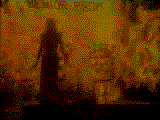In adapting his best-selling novel, The Exorcist for the screen, Peter Blatty changed the gender of the possessed child to female--although he claimed his novel was based on an actual occurrence in which the child was male. It is difficult to imagine that a boy, playing the part of a possessed pubescent, would have horrified an audience to the same extent. When 12-year old Regan, in The Exorcist, urinates on her mother's immaculate carpet, vomits green bile, develops oozing sores her skin, rotates her head on her neck, and utters a string of foul oaths, the contrast between her former "sweet and innocent" feminine self and her present disgusting, abject state is supreme. Audiences were shocked to the core--and loved every moment.
The crucial factor influencing the visual depiction of Regan's possession is sexual. Her first violent act of transgression is shocking. When her distraught mother rushes to her daughter's side, the girl opens her legs, grabs her mother's head, and, forcing it between her bloodied thighs, orders her to perform cunnilinctus. "Lick me! Lick me!," she commands in her newly acquired mannish voice--actually spoken in the film by Mercedes McCambridge. The darting camera becomes Regan's accomplice; through her powers of telekinesis she causes the door to slam shut and sends furniture thudding across the room to block her mother's exit. Regan has become the "damned dirty minded hag" that--given censorship constraints--could only be spoken about, not depicted, in The Innocents. Throughout the film, Regan's lust colours most of her conversation. "Keep away! The sow is mine! Fuck me! Fuck me! Fuck me!," she screams at the priests. In another scene, she orders the priests to sodomise her mother. "Stick your cock up her ass. You mother-fucking worthless cock-sucker." Generally she berates the two clerics for being repressed homosexuals. To hear such lewd, gutter talk pouring from the pus-filled, scabby lips of a once-pretty, feminine teenager is all the more shocking precisely because the monster is female.
But Regan's actions--like the heroines of Heavenly Creatures--are even more transgressive than this. Her desire, focussed exclusively on her mother, is both incestuous and homosexual. With her mannish voice, and outspoken sexual desires for her mother, Regan is essentially an oedipal monster and hysteric. She also wins the battle. By the film's conclusion, she has murdered three men, one of whom she thought was sexually interested in her mother. In the final scene Regan and her mother depart the battleground, arm-in-arm, restored to their former relationship in which they related happily like lovers.
Apart from lesbian/oedipal desire, another factor which distinguishes monstrous little women like Regan, from a male counterpart, is that Regan is experiencing--or about to experience--her first period. Other possession films draw on images of menstrual blood to transform their female stars into monsters. The opening scene of Carrie, associates her demonic powers with menarche. Carrie only acquires the power of telekinesis when she first begins to shed blood. In the Omen IV: The Awakening makes it clear that the young girl is particularly susceptible to possession because she is menstruating. When she enters a stable, the horses go mad. One of the characters points out that horses always become uncontrollable when a
menstruating girl is nearby. (I must remember to tell that
one to my doctor). Audrey Rose, another possessed daughter, also links the teenager's supernatural powers to menstruation.
These films draw a clear connection between pubescent desire, menstruation and possession in order to provide and "explanation" for the attacks of hysteria which engulf the bodies of these monstrous teenage heroines. Like her "spiritual" sisters, each one of these girls is in a border-line condition. Crossing the divide from childhood to womanhood, their bodies are changing from a pre-fertile to a reproductive state. Although Freud argues that men, not just women, also suffered from hysteria, the horror film has marked out this arena for monstrous little women. Because the teenage girl's body is more open to change and alteration (monthly menstruation, pregnancy, lactation) and because she is, presumably, less able to resist the transformative powers of sexual desire and lust she--rather than her male counterpart--is the ruling teen hysteric of horror. An added dimension is the connection drawn by some films between the hysterical female monster and gender transgression. In a number of instances (Carrie, The Exorcist, Heavenly Creatures) the girl is locked in a close--even sexual--relationship with a figure of the same sex (often the mother) which suggests that the hysteria relates to the girl's refusal to conform to her proper feminine gender role which, because of the onset of menstruation, is signalled as fast approaching. She would prefer to remain monstrous and manic, than quietly accept her fate.

